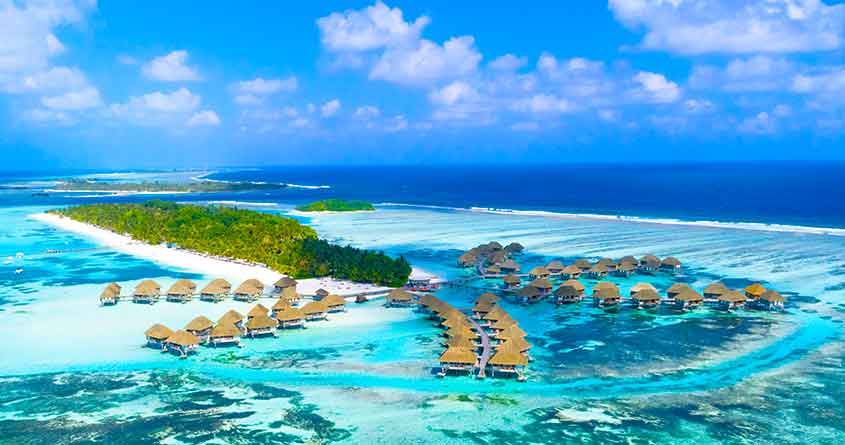How Maldives Plan To Survive Sea-Level Rise
by Oviyaa Venkateshwaran | 20 September 2021
With a population of about 400,000 people, Maldives is a large group of islands found in the southern tip of India.
Located in the Indian Ocean, Maldives is covered by white beaches, palm trees and a natural landscape. As the smallest country in southern Asia, it spreads across an area of 298 sq. km with 1,200 individual coral islands. The 2,500 old nation covers a length of 870 km from north to south and a width of 130 km from east to west.
With beaches and scattered nature forming the top attractions, tourism is the main economy of the island.
But these islands have one very large problem. They are sinking into to sea at a faster rate because of climate change.
This is due to the global temperature rise that leads to melting glaciers and sea-level rise.
Now, the existence of Maldives is threatened by rising sea levels.

The existence of Maldives is threatened by Sea-Level Rise.
Maldives Threatened By Sea-Level Rise
40% of the global population are now living within 100kms of the sea. The Maldives, other islands and major coastal cities like Shanghai and Mumbai are affected by the rise in sea levels.
The Maldives have more than 1000 islands that are less than 1 meter above sea level. This makes it one of the most vulnerable countries due to sea-level rise. The Maldives is affected by other climate change effects like heavy storms, eroding coastlines, less freshwater supply, and decline of habitats.
Due to the island’s low-lying nature, the 2004 Tsunami destroyed about 6 islands and caused several damages.
So how fast are these islands sinking?
The Intergovernmental Panel on Climate Change has projected that the seas will move up by 1.1 metres by the year 2100. This shows the threat of 90% of the island’s existence in the sea.
This means around 1000 islands in Maldives will completely disappear into the sea by 2100.
The government is now making efforts to build an innovative city.

Around 90% of the islands in Maldives are projected to disappear by 2100.
‘A Floating City’ Plan To Tackle Climate Change
To tackle global warming and thrive in sea-level rise, Maldives is planning to survive by building innovative city know as ‘Maldives Floating City (MFC)’. Once completed, the city will invite both residents and visitors.
The ‘floating city’ is developed by a Netherlands-based firm known as Dutch Docklands which specializes in floating developments. They coordinated with the government of Maldives and are planning to build a sustainable floating city.
Normally, land reclamation is the method popularly used to create new land from the sea. China is a great example of a country with a large amount of artificial land reclaimed from its coastlines. But land reclamation has been concerned with climate change effects such as a rise in flooding, storm surges and destruction of coral and marine lives.
Therefore, to promote sustainability, Maldives found creative ways to live in water without land reclamation. So, this floating city development will have only a limited impact for species living in the water.
This sustainable living is planned in a warm-water lagoon in the Indian Ocean. It is situated at a 10-minute boat ride from the capital city of Male and Male International Airport.
The development has been going on for about a decade with the project being in development since 2009.
The city will consist of thousands of waterfront residences that floats along a flexible, functional urban grid across a 200-hectare lagoon. The city will evolve with the growing needs of the country, residents, and visitors.
Since this floating city is one of the first of its kind, it will set an example for surviving the sea-level rise in the future.
The construction will start in 2022 and is set to be completed in phases in the next half-decade.
Sustainable Planning and Design
The floating city’s design plan was inspired by the traditional Maldivian architecture that coordinates with the most eco-friendly construction achievable.
The coral is a critical part of the master plan and since they draw tourists to the nation, the design of the floating city was inspired based on its features. The city is formed of hexagon-shaped segments modelled on a unique geometry of corals and linked to a ring of lush barrier islands.
When the entire city floats up, the island barriers that surround the lagoon will act as breakers down below. This skilful composition reduces the effect of lagoon waves and at the same time balances the structures on the surface.
Sea-front Lifestyle & Affordable Living
The floating city will have low-rise and sea-front developments that consist of residential, commercial, and other amenities located along the palm-lined streets. The homes contain individual units from 100 square meters along with a 40m2 roof terrace and are priced from $250,000. To attract a diverse set of buyers, the prices are also kept affordable.
School, healthcare facility and government buildings are also planned to be integrated with the residential and commercial buildings. By using a smart grid, renewable energy is set to power the developments.
The city promotes a mixed-use lifestyle with easy access to all its basic facilities. This is supported by a system of bridges, canals, and docks which provide a well-connected environment for the people. Situated closer to the existing Male International Airport, the city can connect to other global destinations around the world.